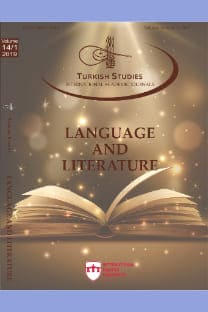Çeviride Modernleşme Girişimleri: Osmanlı Bab-ı Ali ve Çin Jiangnan Arsenal Tercüme Bürosu Örneği
Çeviride Modernleşme Girişimleri: Osmanlı Bab-ı Ali ve Çin Jiangnan Arsenal Tercüme Bürosu Örneği
___
- Akyıldız, A. (1993). Tanzimat dönemi Osmanlı merkez teşkilatında reform (1836-1856). Eren Yayıncılık.
- Aytaş, G. (1999). Osmanlı Devletinde eğitim sistemi. Slh. Kuv. Mzk. Hzl. O. 700. Yıl Bülteni. (1).
- Balcı, S. (2008). Osmanlı Devleti’nde modernleşme girişimlerine bir örnek: lisan mektebi. Tarih Araştırmaları Dergisi. 27(44). 77-98. https://doi.org/10.1501/Tarar_0000000410 Balcı, S. (2013). Babıali Tercüme Odası. Libra Kitap Yayınları.
- Bennett, A. A. (1967). John Fryer: the introduction of Western science and technology into nineteenth- century China. Harvard University East Asian Research Center Press.
- Demirel, Ö. (2004). Yabancı dil öğretimi. Pegem Yayınları.
- Disraeli, B. (1989). Coningsby, or the new generation. Penguin Classics.
- Findley, C. V. (1994). Osmanlı Devletinde bürokratik reform Babıali (1789-1922). (Çev. Latif Boyacı & İzzet Akyol). İz Yayıncılık.
- Fryer, J. (1880). An account of the department for the translation of foreign books at the Kiangnan Arsenal, Shanghai. American Presbyterian Mission Press.
- Göçek, F. M. (1999). Burjuvazinin yükselişi imparatorluğun çöküşü Osmanlı batılaşması ve toplumsal değişme. (Çev. İbrahim Yıldız ). Ayraç Yayınevi.
- Gürçağlar, Ş. T. (2014). Çevirinin abc’si. Say Yayınları.
- Hermans, T. (2004). Translation in systems: descriptive and system-oriented approaches explained. Shanghai Foreign Language Education Press.
- Hezarfen, H. (1998). Telhisü’l- beyan fi Kavanin-i Al-i Osman. (Haz. Sevim İlgürel ). Türk Tarih Kurumu.
- Karal, E. Z. (1994). Osmanlı tarihi V. cilt. Türk Tarih Kurumu.
- Kissinger, H. (2014). Çin: dünden bugüne yeni Çin. (Çev. Nalan Işık Çeper ). Kaknüs Yayınları.
- Lewis, B. (1996). İslam dünyasında Yahudiler. (Çev. Bahadır Sina Şener). İmge Kitabevi.
- Lewis, B. (2000). Modern Türkiye’nin doğuşu. (Çev. Metin Kıratlı). Türk Tarih Kurumu.
- Lewis, B. (2002). The emergence of modern Turkey. Oxford University Press.
- Li, N. (黎難秋). (2006). 中國科學翻譯史 (Zhongguo kexue fanyishi / The history of science translation in China). Zhongguo Kexue Jishu Daxue Chubanshe.
- Lybyer, A. H. (2000). Kanuni Sultan Süleyman döneminde Osmanlu imparatorluğunun yönetimi. (Çev. Seçkin Cılızoğlu). Sarmal Yayınları.
- Ortaylı, İ. (1985). “Osmanlı diplomasisi ve dışişleri örgütü.” Tanzimattan Cumhuriyete Türkiye Ansiklopedisi.1. İletişim Yayınları. 278-281.
- Özkan, S. H. (2010). Osmanlı Devleti’nde yabancı dil eğitimi. Turkish Studies International Periodical For the Languages, Literature and History of Turkish or Turkic. 5(3). 1783- 1800. https://dx.doi.org/10.7827/TurkishStudies.1346
- Shayegan, D. (2014). Yaralı bilinç. Metis Yayınları.
- Soner, O. (2007). Türkiye’de yabancı dil eğitiminin dünü bugünü. Marmara Üniversitesi Öneri Dergisi. 7(28). 397-404. https://doi.org/10.14783/maruoneri.684553
- Şeşen, R. (2002). Osmanlı ilmi, Osmanlılar’ın ilimlere yaklaşımı. İstanbul Üniversitesi Edebiyat Fakültesi Tarih Dergisi. 0(37). 329-348. https://dergipark.org.tr/tr/pub/iutarih/issue/9609/120028
- Teng, S. & Fairbank, J. (1979). China’s response to the West: a documentary survey, 1839-1923. Harvard University Press.
- Tsien, T. (1954). Western impact on China through translation. The Far Eastern Quarterly. 13(3). 305-327. https://doi.org/10.2307/2942281
- Ülken, H. Z. (2009). Uyanış devirlerinde tercümenin rolü. İş Bankası Kültür Yayınları.
- Wang, Y. 王揚宗 (2000). 傅蘭雅與近代中國的科學啟蒙/ Fu lanya yu jindai Zhongguo de kexue qimeng (John Fryer and the scientific enlightenment of pre-modern China). Kexue Chubanshe.
- Wright, D. (2000). Translating science: the transmission of western chemistry into late imperial China, 1840-1900. Brill.
- ISSN: 2667-5641
- Yayın Aralığı: 4
- Başlangıç: 2006
- Yayıncı: ASOS Eğitim Bilişim Danışmanlık Otomasyon Yayıncılık Reklam Sanayi ve Ticaret LTD ŞTİ
Hızır bin Abdullah’ın Kitab’ü-l Edvar’ında Müzik ve Kozmogoni
Çeviride Modernleşme Girişimleri: Osmanlı Bab-ı Ali ve Çin Jiangnan Arsenal Tercüme Bürosu Örneği
Çile Maden KALKAN, Aylin Yılmaz ŞAŞMAZ
Yaşar Kemal’in Ölmez Otu Romanında Mekânsal Referans Çerçeveleri
Repetition and Contribution to Poetic Excitement in Poetry, The Example of Baudelaire
Turgay Kantürk’ün “Otel” Öyküsü* Üzerine Bir Çözümleme
A Research On Science-Fiction in Turkish Novel
Mesut TEKŞAN, Melek İlayda SARI
Çeviri, Sermaye ve Kimlik Edinci İlişkisi
Nazariyatçı Bestekârlara Göre Türk Müziğinin Biçimsel Analizi
